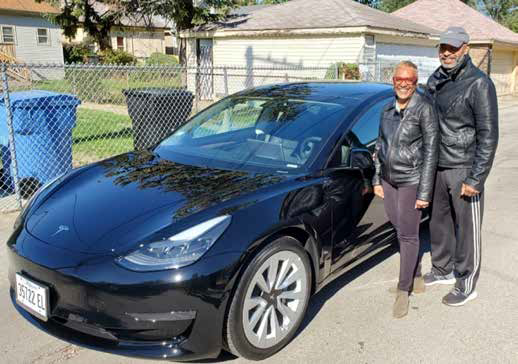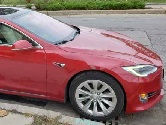
Carl Golden, owner of Golden’s Tropical World pet supply store, is a man who loves technology. He is what marketers like to call an early adopter and a bit of a technophile, quick to try out new things. So, it was no surprise that when electric cars became available to the public, he bought one. His first electric vehicle (EV) was a new 2012 Chevy Volt. Today, he drives a Tesla Model S, which he charges at home in his garage and drives to work every day. Thanks to the Climate and Equitable Jobs Act (CEJA), there could be a million more like Carl Golden making the switch to EVs by 2030.
When Governor Pritzker signed Illinois’ groundbreaking new clean energy bill (SB2408) into law last month after years of delay in Springfield, newspaper headlines and editorial writers touted it as the most sweeping climate reform legislation in the nation. SB2408 has the potential to create tens of thousands of new green energy jobs, steering Illinoisans away from fossil fuels like coal, oil, and natural gas, which are destroying the planet. More importantly, legislators crafted the law to begin the reform process in the hardest-hit communities first. These are the black and brown communities who are exposed to vehicle exhausts along the interstates and live in closest proximity to industrial corridors and waste landfills. These communities are in greatest need and will benefit most from the clean air reforms coming out of CEJA.
[Map from Natural Resources Defense Council (NRDC) shows the negative impact of environmental injustice on vulnerable black and brown communities on the south and west sides of Chicago, where populations have shorter lifespans and suffer higher rates of asthma, heart and lung disease, hypertension, high blood pressure, and various cancers.]
CEJA Leans Heavily into Electric Vehicles (EVs)
From a save-the-planet point of view, we at Jitney EV and other advocates of electric vehicle transportation think this new law hits all the sweet spots. It offers hefty price incentives of up to $4,000 to help persuade car owners to give up their gas guzzlers in favor of low-maintenance, energy-efficient EVs. It also offers rebates and incentives for EV charging infrastructures, which are essential to help convince car buyers to make the switch. Increasing the availability of EV charging stations also helps to alleviate “range anxiety,” which is the discomfort and uncertainty EV drivers feel when they must search for places to charge their cars, especially when traveling long distances. That anxiety is worse in black and brown communities, which tend to be in EV charging deserts, where few charging options exist.
“We are standing at the starting line of an electric vehicle revolution,” said U.S. Senator Richard Durbin. “If the federal government can complement Pritzker’s commitment, Illinois is poised to win,” he added. Governor Pritzker was referring to President Biden’s ambitious Build Back Better agenda. This agenda includes adding a half-million public EV charging stations throughout the nation, with a goal of making 50% of new car sales electric by 2030.
The federal plan dovetails with Illinois’ CEJA legislation to make EV adoption too attractive to pass up at this moment in time. The federal plan offers rebates of up to $7,500 on purchases of new model EVs and more rebates and incentives for EV charging infrastructures. The following list are electric cars eligible for the $7,500 tax credit.
The federal government can complement Pritzker’s commitment, Illinois is poised to win,” he added. Governor Pritzker was referring to President Biden’s ambitious Build Back Better agenda. This agenda includes adding a half-million public EV charging stations throughout the nation, with a goal of making 50% of new car sales electric by 2030.
The federal plan dovetails with Illinois’ CEJA legislation to make EV adoption too attractive to pass up at this moment in time. The federal plan offers rebates of up to $7,500 on purchases of new model EVs and more rebates and incentives for EV charging infrastructures. The following list are electric cars eligible for the $7,500 tax credit.
• Audi eTron, eTron Sportback
• BMW i3
• Hyundai Ioniq EV
• Hyundai Kona EV
• Jaguar I-nPace
• Karma Revero
• Kia Niro EV
• Mini Cooper SE Hardtop
• Nissan Leaf
• Polestar 1
• Polestar 2
• Porsche Taycan
• Volvo XC40 Recharge
• Volkswagen ID.4
The federal rebates do not apply to EV models, like Tesla, that have sold more than 200,000 units in the U.S.]
We thought it would be helpful to learn first-hand from EV owners about their journey to EV adoption.


Wayne and Lorraine Morgan
Wayne and Lorraine Morgan had a much different journey into the world of EV ownership than did Mr. Golden. We visited the Morgan’s at their home in Chatham and asked them to share their story about choosing to drive EV.
“Actually, it was my husband’s idea,” Lorraine said, explaining why they decided to buy an electric car.
“I used to work for ComEd,” Wayne said. “I worked at a nuclear station and got to see the transition over the years, and I got a sense of the damage that fossil fuels have done to the environment. I have a couple of good friends who have electric vehicles and they talked highly about them. Then, I just wanted to get ahead of the curve. I know this is the wave of the future and, you know, I have a gas guzzler. I was pouring a lot of money into my old Buick. The most impressive thing we learned about electric cars is the low maintenance. You know, there’s only one fluid in that car, and that’s the windshield wiper fluid.”
We just decided this is the future, and we do believe in reducing the carbon footprint. So, let’s look more into this.”
Lorraine gets excited when talking about all of the car’s safety features.
“Everything you do with the car is through your phone, from opening the door, to plugging in the charger, and that’s different. It was a little intimidating at first. I mean, then you have this big oversize computer screen and you’re touching the screen through everything from adjusting mirrors, to setting speed limits, to controlling the volume on the radio. And the car has like 12 cameras. It is always taking pictures. Every time you honk the car, it is taking a snapshot of what’s going on to protect you. So, there are a lot of safety features built in.
Wayne did make some modifications at home to accommodate the new technology. He extended his Wi-Fi signal out to the garage so the car can update, the same way cell phones constantly update to add features. Wayne, however, was most impressed by the regenerative braking system, which slows the car by taking your foot off the brake and redirecting the flow of energy to decelerate. Lorraine says she expects her brakes to last at for at least 100,000 miles.
The Morgans do expect to replace their second car with an EV as soon as next year. In this way, they can take advantage of the huge incentives included in CEJA and Build Back Better.
William P. “Billy” Davis is co-founder and general manager of Jitney EV, an Electric Vehicle Transportation and EV Charging Company serving Bronzeville, Chicago, and beyond. Their mission is to grow the presence of EV Transportation and EV Charging infrastructures in communities most impacted by environmental pollution. Electrification of transportation is the shortest path to a clean air, clean energy future. It is key to the sustainability and resiliency of our community and helps transition our workforce from blue collar to green collar jobs.









